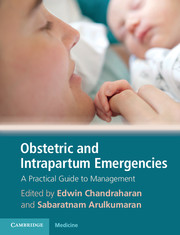Book contents
- Obstetric and Intrapartum Emergencies
- Obstetric and Intrapartum Emergencies
- Copyright page
- Contents
- Preface
- Acknowledgements
- Contributors
- Section 1 GeneralPrinciples
- Section 2 Algorithms for Management of the Top Five ‘Direct Killers’
- Section 3 Intrapartum Emergencies
- Section 4 PostpartumEmergencies
- Section 5 Medical and Surgical Emergencies during Pregnancy
- 21 Palpitations during pregnancy
- 22 Breathlessness
- 23 Abdominal pain inpregnancy
- 24 Blurring of vision andsudden loss of vision in pregnancy
- 25 Psychiatric emergencies
- 26 Drug overdosein pregnancy
- 27 Diabeticketoacidosis in pregnancy
- 28 Convulsions and epilepsy
- 29 Musculoskeletalconsiderations in pregnancy
- 30 Endocrineemergencies in pregnancy
- Section 6 Anaesthetic Emergencies. Section Editor: Anthony Addei
- Section 7 NeonatalEmergencies and Resuscitation
- Section 8 Management ofAnticipated and Non-anticipated Emergencies
- Section 9 Setting up Skillsand Drills Training in Maternity Services
- Index
29 - Musculoskeletalconsiderations in pregnancy
from Section 5 - Medical and Surgical Emergencies during Pregnancy
Published online by Cambridge University Press: 05 November 2012
- Obstetric and Intrapartum Emergencies
- Obstetric and Intrapartum Emergencies
- Copyright page
- Contents
- Preface
- Acknowledgements
- Contributors
- Section 1 GeneralPrinciples
- Section 2 Algorithms for Management of the Top Five ‘Direct Killers’
- Section 3 Intrapartum Emergencies
- Section 4 PostpartumEmergencies
- Section 5 Medical and Surgical Emergencies during Pregnancy
- 21 Palpitations during pregnancy
- 22 Breathlessness
- 23 Abdominal pain inpregnancy
- 24 Blurring of vision andsudden loss of vision in pregnancy
- 25 Psychiatric emergencies
- 26 Drug overdosein pregnancy
- 27 Diabeticketoacidosis in pregnancy
- 28 Convulsions and epilepsy
- 29 Musculoskeletalconsiderations in pregnancy
- 30 Endocrineemergencies in pregnancy
- Section 6 Anaesthetic Emergencies. Section Editor: Anthony Addei
- Section 7 NeonatalEmergencies and Resuscitation
- Section 8 Management ofAnticipated and Non-anticipated Emergencies
- Section 9 Setting up Skillsand Drills Training in Maternity Services
- Index
Summary
- Type
- Chapter
- Information
- Obstetric and Intrapartum EmergenciesA Practical Guide to Management, pp. 198 - 203Publisher: Cambridge University PressPrint publication year: 2012
- 1
- Cited by

